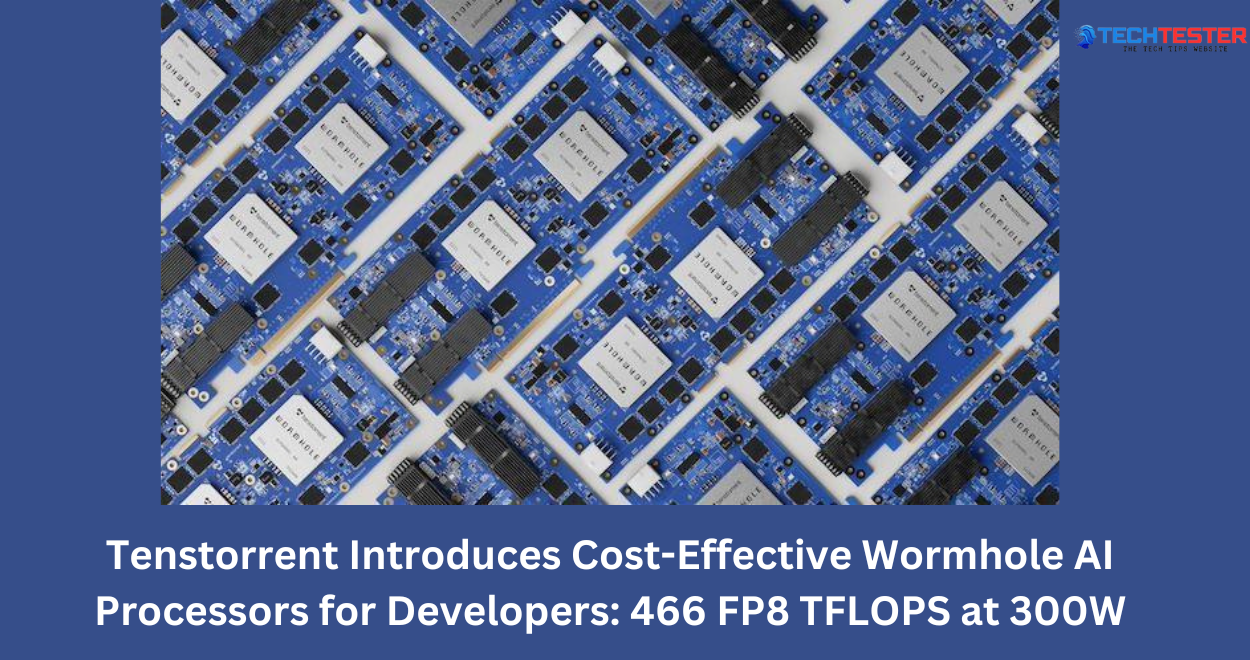In a significant move for the AI hardware industry, Tenstorrent has unveiled its next-generation Wormhole processors, designed to deliver impressive performance at an affordable price point. This release targets developers and could potentially reshape the landscape of AI acceleration.
Wormhole Processor: A New Contender in AI Hardware
Tenstorrent’s Wormhole processor is the heart of this new offering. Each chip boasts:
72 Tensix cores, each featuring five RISC-V cores supporting various data formats
108 MB of SRAM
Performance of 262 FP8 TFLOPS at 1 GHz with a 160W thermal design power
Two Powerful PCIe Card Options
Tenstorrent is introducing two PCIe card variants:
Image source: ANANDTECH
Wormhole n150: A single-chip card delivering 262 FP8 TFLOPS at 160W, equipped with 12 GB of GDDR6 memory and 288 GB/s bandwidth.
Wormhole n300: A dual-chip powerhouse offering up to 466 FP8 TFLOPS at 300W, featuring 24 GB of GDDR6 memory and an impressive 576 GB/s bandwidth.
Scalability: A Key Advantage
Another interesting thing about Wormhole which sets it apart from its competitors is its scalability. When four Wormhole n300 cards are installed in a standard workstation configuration, the processors are capable of working as a single coherent structure which looks like a single network of Tensix cores to the software. This configuration allows for:
Completing the same amount of work
Division among four developers
It can run up to eight different AI models concurrently
Most importantly, this scalability works in a non-virtualized manner to boost performance and ease expansion.
Developer-Focused Workstations
To complement the PCIe cards, Tenstorrent is offering two pre-built workstation options:
TT-LoudBox: A cheaper version based on the Intel Xeon processors and equipped with active cooling systems.
TT-QuietBox: A premium solution based on the EPYC processors and utilizing the liquid cooling system.
The two workstations include four NVIDIA n300 cards each to support complex development of artificial intelligence projects.
Performance and Price: A Competitive Edge
While Tenstorrent’s Wormhole processors may not match the raw performance of top-tier options like NVIDIA’s H100, they offer a compelling value proposition:
Wormhole n150: Priced at $999
Wormhole n300: $1,399
On the other hand, an NVIDIA H100 card can cost anywhere between $30,000 and more depending on the quantity. This strong price disparity may make Wormhole appealing for developers and organizations with limited capital.
Comparison to Market Leader NVIDIA
NVIDIA’s H100 provides 1,670 FP8 TFLOPS (3,341 TFLOPS with sparsity) at 300W.
Tenstorrent’s Wormhole n300 provides 466 FP8 TFLOPS at 300W.
The performance difference is quite significant but the price difference may make Wormhole a viable solution for many applications.
However, Tenstorrent is not complacent. It’s noteworthy that CEO Jim Keller shared that the company is already working on the second-generation chip codenamed “Blackhole.”
Conclusion
Wormhole processors from Tenstorrent are a step closer to making AI acceleration hardware more attainable. Tenstorrent aims to disrupt the current AI hardware market by providing decent performance at a significantly lower price than the premium solutions. When developers get a hold of these new tools, it will be quite fascinating to note how they alter the landscape of AI development and if they can displace NVIDIA in some segments of the market.
FAQs
Q1: How does the Wormhole n300 perform?
A: The Wormhole n300 can deliver up to 466 FP8 TFLOPS at 300W.
Q2: What is unique about Wormhole’s scalability?
A: Wormhole processors can work together as a unified network of Tensix cores without requiring virtualization, allowing for flexible workload distribution.
Q3: Who is the target audience for these processors?
A: The Wormhole processors are primarily aimed at developers and organizations looking for cost-effective AI acceleration solutions.
Q4: Can Wormhole processors run multiple AI models simultaneously?
A: Yes, a configuration with four Wormhole n300 cards can run up to eight distinct AI models at the same time.
Q5: What’s next for Tenstorrent?
A: Tenstorrent is already working on their second-generation chip called “Blackhole,” which is currently in development.
Q6: How much memory do the Wormhole cards have?
A: The Wormhole n150 has 12 GB of GDDR6 memory, while the n300 has 24 GB.
Q7: What types of cooling are used in Tenstorrent’s workstations?
A: The TT-LoudBox uses active cooling, while the premium TT-QuietBox features liquid cooling.
Amit Gupta is a tech lover and an enthusiastic blogger who completed his B.Tech in Computer Science. An enthusiast of emerging technology and discoveries, he shares valuable views and tips on his blog from his personal experiences. Through his articles, he tries to simplify tech concepts and put readers in the position to take responsible decisions in the rapidly changing digital infrastructure world. Follow me on Facebook and linkedin.

